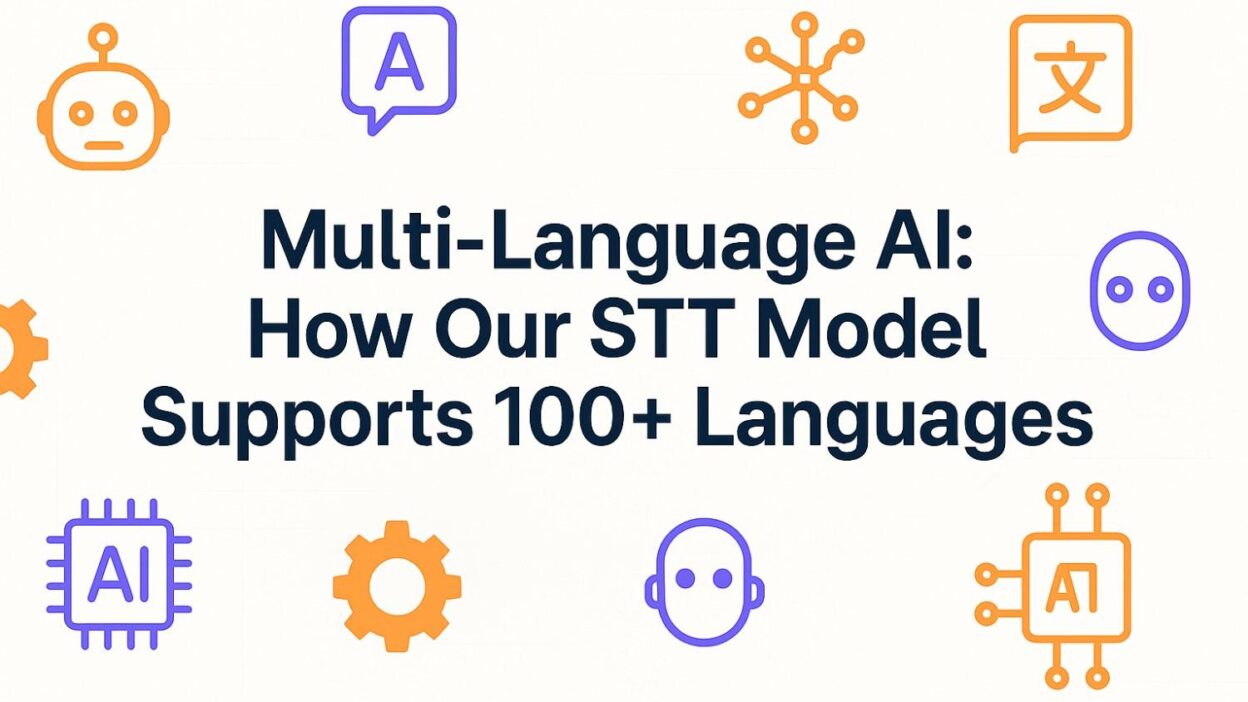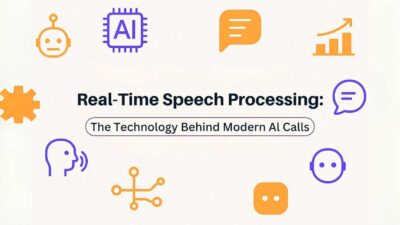In today’s interconnected global economy, businesses serve customers who speak dozens of different languages and come from diverse cultural backgrounds. The ability to communicate effectively across language barriers has become a critical competitive advantage, yet most speech-to-text technologies have historically been limited to a handful of major languages. Our revolutionary multi-language AI speech-to-text model breaks through these limitations, providing accurate transcription and understanding across more than 100 languages, dialects, and regional variations
Table of Contents
The Global Communication Challenge
The modern business landscape demands multilingual communication capabilities that traditional speech recognition systems simply cannot provide. While English, Spanish, and Mandarin represent large user bases, the reality is that customers worldwide speak hundreds of languages, each with unique phonetic structures, grammatical rules, and cultural contexts that affect speech patterns.
Consider the complexity: a global customer service operation might need to handle calls in Arabic, Hindi, Portuguese, Russian, Japanese, and Swahili within a single hour. Traditional speech-to-text systems would require separate models for each language, creating technical complexity, increased costs, and inconsistent performance across different languages. The challenge becomes even more complex when accounting for regional dialects, accents, and code-switching between languages within single conversations.
Our multi-language AI addresses this challenge through a unified approach that recognizes and processes multiple languages simultaneously, eliminating the need for language detection preprocessing and providing seamless support for multilingual conversations that reflect how people actually communicate in our globalized world.
The Technology Behind Multi-Language AI
Building a speech-to-text model that accurately handles 100+ languages required fundamental innovations in neural network architecture and training methodologies. Traditional approaches trained separate models for each language, creating silos that couldn’t leverage shared linguistic features or transfer learning between related languages.
Our multi-language AI utilizes a transformer-based architecture with shared encoder layers that learn universal acoustic and linguistic patterns while maintaining language-specific decoder heads for optimal accuracy in each supported language. This approach allows the model to leverage commonalities between languages while preserving the unique characteristics that make each language distinct.
The training process involved analyzing over 50,000 hours of multilingual audio data, representing natural speech patterns from native speakers across all supported languages. This massive dataset includes formal speech, casual conversations, technical discussions, and emotional expressions to ensure robust performance across diverse communication contexts.
Advanced attention mechanisms enable the model to focus on relevant acoustic features for each language while suppressing interference from similar sounds in other languages. This is particularly crucial for distinguishing between languages that share phonetic similarities but have different meanings for similar sounds.
Comprehensive Language Coverage
Our multi-language AI supports an unprecedented range of languages, from widely spoken international languages to regional dialects and indigenous languages that are often overlooked by mainstream technology providers. The coverage includes all major language families: Indo-European, Sino-Tibetan, Afroasiatic, Niger-Congo, Austronesian, and many others.
Major international languages receive premium support with accuracy rates exceeding 95% for clear speech. These include English, Spanish, French, German, Italian, Portuguese, Russian, Arabic, Mandarin, Japanese, Korean, and Hindi. But our commitment extends far beyond these commonly supported languages.
Regional languages across Africa, Asia, and Latin America receive comprehensive support, including Yoruba, Igbo, Hausa, Telugu, Tamil, Bengali, Thai, Vietnamese, Tagalog, and dozens of others. This inclusive approach ensures that businesses can serve diverse customer bases without language barriers limiting their reach or service quality.
Indigenous and minority languages are also supported, reflecting our commitment to linguistic diversity and inclusion. Languages like Quechua, Navajo, Welsh, and Hawaiian are included in our model, enabling organizations to serve communities that have been historically underserved by technology providers.
Real-Time Processing Capabilities
One of the most impressive aspects of our multi-language AI is its ability to process speech in real-time across all supported languages simultaneously. Traditional multilingual systems require pre-processing to identify the spoken language, introducing delays that make real-time applications impractical.
Our system processes audio streams continuously, identifying languages and generating transcriptions with latency under 200 milliseconds for most languages. This real-time performance makes the technology suitable for live customer service, conference calls, and interactive applications where delays would negatively impact user experience.
The real-time capabilities extend to code-switching scenarios where speakers transition between languages within single sentences or conversations. Our model detects these transitions and adjusts processing accordingly, maintaining accuracy and context across language switches that are common in multilingual environments.
Automatic punctuation and formatting are applied in real-time according to the conventions of each detected language, ensuring that transcriptions are immediately usable without post-processing. This includes proper capitalization, sentence boundaries, and language-specific formatting rules.
Accuracy Across Diverse Languages
Achieving high accuracy across 100+ languages presents unique challenges, as each language has distinct acoustic properties, grammatical structures, and cultural communication patterns that affect speech recognition performance. Our multi-language AI addresses these challenges through language-specific optimization while maintaining the benefits of a unified model.
Accuracy rates vary by language based on factors like training data availability, phonetic complexity, and the prevalence of regional variations. For major international languages with extensive training data, our model achieves accuracy rates of 95-98% for clear speech under good acoustic conditions.
Languages with complex phonetic structures or extensive regional variations, such as Arabic with its numerous dialects or Chinese with its tonal variations, maintain accuracy rates of 90-95% through specialized handling of language-specific features. Even for languages with limited training data, our model achieves accuracy rates of 85-90% by leveraging cross-linguistic transfer learning.
The accuracy measurements account for real-world conditions including background noise, multiple speakers, and varying audio quality. Our model includes robust noise suppression and speaker separation capabilities that maintain performance even in challenging acoustic environments.
Handling Dialects and Regional Variations
Languages are living, evolving systems with significant regional variations that can dramatically affect speech recognition accuracy. Our multi-language AI recognizes that supporting “Spanish” requires understanding Mexican Spanish, Argentinian Spanish, Peninsular Spanish, and dozens of other regional varieties, each with unique pronunciation patterns, vocabulary, and grammatical structures.
The model includes specific support for major dialect groups within each language. For English, this includes American, British, Australian, South African, and Indian English variants. For Arabic, the model handles Modern Standard Arabic alongside major regional dialects including Egyptian, Levantine, Gulf, and Maghrebi varieties.
Regional variation support extends beyond major languages to include dialect groups within smaller language communities. This granular approach ensures accurate recognition regardless of where speakers learned their language or which regional variety they use naturally.
Dynamic adaptation capabilities allow the model to adjust to speaker-specific pronunciations and regional features within conversations, improving accuracy over time as more speech data becomes available from each speaker.
Technical Architecture and Innovation
The underlying architecture of our multi-language AI represents significant innovations in neural network design for speech recognition. The model uses a hierarchical structure with shared lower layers that process universal acoustic features and specialized upper layers that handle language-specific patterns.
Cross-lingual attention mechanisms enable the model to leverage information from similar languages when processing unfamiliar inputs, improving accuracy for languages with limited training data. This approach is particularly effective for related languages that share linguistic features or historical connections.
The model incorporates advanced noise robustness features including spectral gating, dynamic range compression, and adaptive filtering that maintain performance across diverse acoustic environments. These features are particularly important for multilingual applications where speakers may be calling from various locations with different background noise characteristics.
Memory-efficient processing enables the model to maintain all language capabilities simultaneously without the computational overhead typically associated with running multiple separate models. This efficiency makes the technology practical for deployment in resource-constrained environments while maintaining full multilingual capabilities.
Integration and Implementation
Implementing multi-language AI speech-to-text capabilities requires careful consideration of system architecture, data flow, and user experience design. Our model provides flexible integration options that accommodate various technical requirements and deployment scenarios.
API integration allows developers to incorporate multilingual speech recognition into existing applications with minimal code changes. The API handles language detection automatically and returns structured results including transcription, detected language, confidence scores, and alternative interpretations for ambiguous segments.
Real-time streaming interfaces support live audio processing for applications like customer service systems, conference platforms, and interactive voice applications. The streaming API provides continuous transcription updates with minimal latency while maintaining context across language transitions.
Batch processing capabilities enable efficient transcription of large volumes of multilingual audio content, such as recorded customer calls, meeting recordings, or media files. Batch processing includes advanced features like speaker diarization, sentiment analysis, and key phrase extraction across all supported languages.
Performance Optimization Strategies
Optimizing multi-language AI performance requires balancing accuracy, speed, and resource utilization across diverse linguistic requirements. Our implementation includes several optimization strategies that ensure consistent performance regardless of language complexity or usage patterns.
Adaptive model loading adjusts computational resources based on detected languages, allocating additional processing power to languages with higher complexity or accuracy requirements. This approach ensures optimal performance for each language without wasting resources on unnecessary computations.
Caching mechanisms store frequently used linguistic models and phonetic patterns to reduce processing latency for common language combinations. The caching system adapts to usage patterns, preloading models for languages that are likely to be encountered based on historical data and geographic context.
Quality assurance monitoring continuously evaluates transcription accuracy across all supported languages, identifying potential issues and triggering automatic model updates when performance degrades. This monitoring ensures consistent quality as the system processes diverse multilingual content.
Use Cases and Applications
Multi-language AI speech-to-text technology enables numerous applications that were previously impractical due to language barriers and technical limitations. Customer service operations represent one of the most impactful use cases, allowing companies to provide consistent service quality regardless of customer language preferences.
Global conference platforms utilize multi-language AI to provide real-time transcription and translation services, enabling participants to follow discussions in their preferred language while maintaining the natural flow of multilingual conversations. This capability is particularly valuable for international business meetings and educational conferences.
Content creators and media organizations use multi-language AI to generate subtitles and transcriptions for multilingual content, reducing the time and cost associated with manual transcription services. The technology handles complex scenarios like interviews with multiple speakers using different languages.
Legal and compliance applications benefit from accurate multilingual transcription for depositions, court proceedings, and regulatory documentation. The high accuracy requirements of legal applications are met through specialized models trained on legal terminology across multiple languages.
Quality Assurance and Continuous Improvement
Maintaining high accuracy across 100+ languages requires comprehensive quality assurance processes and continuous improvement methodologies. Our approach includes automated testing, human validation, and feedback-driven optimization to ensure consistent performance across all supported languages.
Automated testing processes continuously evaluate model performance against benchmark datasets for each supported language. These tests identify potential accuracy degradation and trigger alerts when performance falls below acceptable thresholds for any language or dialect group.
Human validation involves native speakers reviewing transcriptions and providing feedback on accuracy, naturalness, and cultural appropriateness. This feedback is incorporated into model training to address language-specific issues and improve performance for underrepresented languages.
Active learning systems identify challenging audio segments and prioritize them for additional training data collection. This approach ensures that the model continues improving in areas where accuracy is most needed while efficiently utilizing training resources.
Challenges and Solutions
Developing multi-language AI that performs consistently across 100+ languages presents numerous technical and practical challenges. Data availability varies dramatically between languages, with some having extensive audio corpora while others have limited training resources available.
Our solution includes sophisticated transfer learning techniques that enable languages with limited data to benefit from models trained on related languages. This approach leverages linguistic similarities and shared acoustic features to achieve good performance even for languages with minimal training data.
Computational complexity increases significantly when supporting numerous languages simultaneously. Our architectural innovations include efficient attention mechanisms and dynamic model loading that maintain reasonable computational requirements while preserving full multilingual capabilities.
Cultural and contextual variations within languages require nuanced understanding that extends beyond simple phonetic recognition. Our training approach includes cultural context and pragmatic understanding to ensure appropriate interpretation of speech across diverse cultural backgrounds.
Future Developments and Roadmap
The evolution of multi-language AI continues with planned enhancements that will expand capabilities and improve performance across existing and new languages. Upcoming developments include support for additional indigenous languages, improved dialect recognition, and enhanced emotional understanding across cultures.
Advanced multilingual understanding will incorporate semantic analysis and intent recognition that maintains accuracy across languages and cultural contexts. This evolution will enable applications that understand not just what is said, but what is meant within specific cultural frameworks.
Integration with translation technologies will provide seamless multilingual communication where speakers can communicate in their preferred languages while others receive real-time translation. This capability will break down language barriers in ways that were previously impossible.
Expanded customization options will allow organizations to fine-tune the model for industry-specific terminology, organizational vocabulary, and specialized use cases while maintaining broad multilingual capabilities.
The Impact of Multi-Language AI
Multi-language AI speech-to-text technology represents a fundamental shift in how organizations approach global communication and customer service. By eliminating language barriers, businesses can serve diverse customer bases more effectively while reducing the costs and complexity associated with multilingual operations.
The technology democratizes access to advanced speech recognition capabilities for languages and communities that have been underserved by mainstream technology providers. This inclusivity enables organizations to serve previously unreachable markets while respecting linguistic diversity and cultural preferences.
Economic benefits extend beyond cost savings to include new revenue opportunities from expanded market reach and improved customer satisfaction across diverse linguistic groups. Organizations implementing multi-language AI often discover new business opportunities in markets they previously considered inaccessible due to language barriers.
The social impact includes greater accessibility for speakers of minority languages and improved inclusion in digital services that were previously available only in major international languages. This broader accessibility contributes to digital equity and linguistic preservation efforts.
Implementation Best Practices
Successful implementation of multi-language AI requires careful planning and consideration of organizational needs, technical requirements, and user expectations. Best practices include thorough requirements analysis, pilot testing with diverse language groups, and gradual rollout strategies that allow for optimization and refinement.
Training staff to work effectively with multi-language AI systems ensures optimal utilization and helps identify potential improvements or customization opportunities. This training should include understanding of system capabilities, limitations, and appropriate use cases for different languages and scenarios.
Integration planning should account for existing systems, data flows, and user workflows to minimize disruption while maximizing the benefits of multilingual capabilities. Successful integrations often involve phased approaches that gradually expand language support as capabilities are proven and optimized.
Performance monitoring and optimization should be ongoing processes that track accuracy, user satisfaction, and system performance across all supported languages. Regular review and adjustment ensure that the system continues meeting organizational needs as requirements evolve and new languages are added.
Multi-language AI speech-to-text technology represents a transformative capability that enables truly global communication and service delivery. Our support for 100+ languages eliminates traditional barriers and opens new possibilities for organizations seeking to serve diverse, international customer bases with the same level of quality and efficiency they provide to their primary language markets. The technology continues evolving, promising even greater capabilities and broader language support in the future.
📧 Email: [email protected]
📞 Phone: 1-347-543-4290
🌐 Website: emasterlabs.com
📍 Address: 1942 Broadway Suite 314 Boulder, CO 80302 USA
Engineer Master Labs – You Think, We Automate, You Profit





